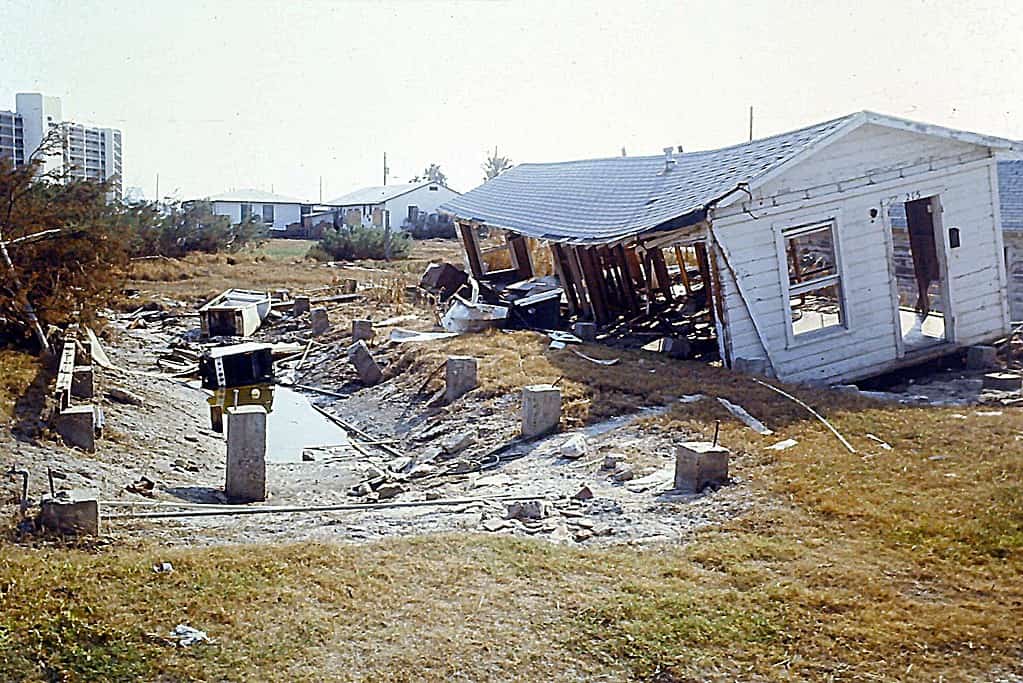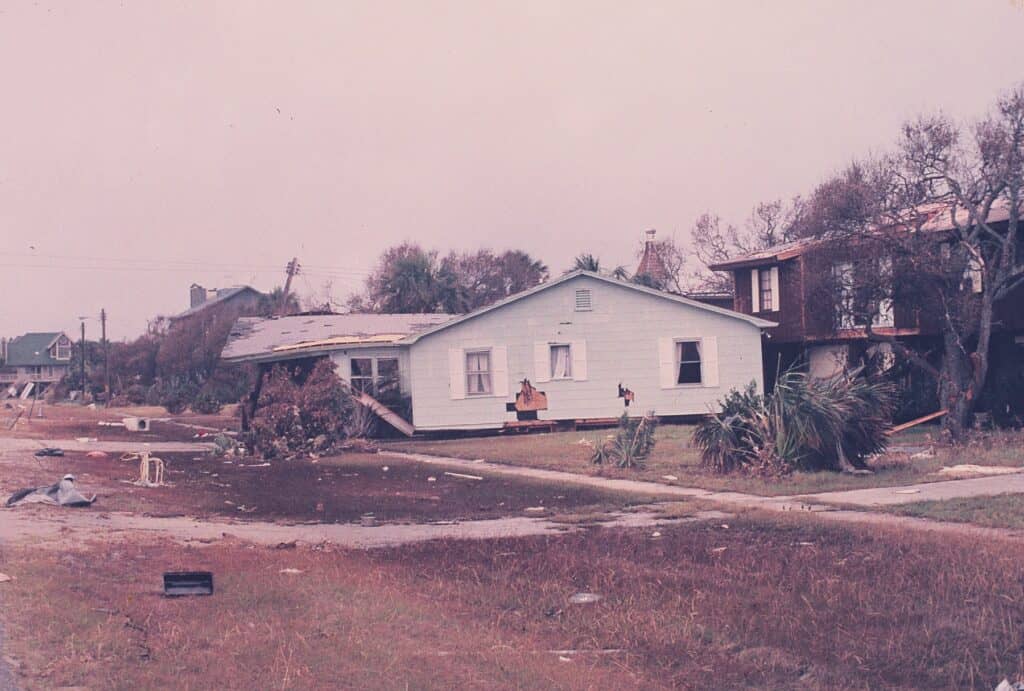Even though the winds of any hurricane can be lethal, only hurricanes with ratings of Category 3 or higher are deemed major storms. Large hurricanes can kill many people and cause widespread damage to property due to the sheer ferocity of their winds. This article takes a retrospective look at the most catastrophic hurricanes to strike the United States during the 1980s. The storms of particular interest will be category 3 hurricanes or above, though we will investigate those that caused significant damage or casualties regardless of status. Our focus will be limited to Atlantic hurricanes that made U.S. landfall. In contrast to the Atlantic, the Pacific Ocean does not experience hurricanes that reach landfall on the United States mainland. Let’s get started then!
1980
Hurricane Allen

Property damage in Corpus Christi, TX from Hurricane Allen, 1980.
An unprecedented nine hurricanes formed in the Atlantic during the 1980 season. The previous high number was recorded in 1969. In August of 1980, Storm Allen, a rare and very violent Cape Verde hurricane, wreaked havoc across the Caribbean, eastern and northern Mexico, and southern Texas. The storm was so severe that it was classified as a Category 5 storm, making it the most destructive of the season. Allen has the distinction of having the highest sustained winds ever recorded in the Atlantic basin, reaching 190 miles per hour. At least 269 people were killed and $1.57 billion in property was damaged because of Allen, the majority of which was in Haiti and the United States.
1981
Hurricane Dennis and Tropical Depressions Eight and Two
All 12 tropical or subtropical storms that formed in the Atlantic during the 1981 hurricane season had some sort of impact on the land. Only three of these hurricanes became big ones. As luck would have it, casualties were remarkably low throughout the season. Curiously, none of the major hurricanes were blamed for any fatalities or significant property damage. Tropical Depressions Nos. 8 and 2 were responsible for almost $60,000,000 in damages and 8 deaths. Category 1 Hurricane Dennis killed 3 people and cost about $30,000,000 in damages. On the count of eight, disaster struck the South Central United States, including Alabama and Tennessee. In the United States, two hit Texas in the south and Maryland in the middle. The Southeastern United States was impacted by Dennis, including North Carolina and Florida.
1982
Hurricane Alberto and Subtropical Storm One
There were only five tropical storms and one subtropical storm in the Atlantic during the 1982 hurricane season. Two of the storms strengthened into hurricanes, and while one of them (Debbie) attained significant hurricane status (category 4), it caused only minor damage and, mercifully, no fatalities. Alberto, a category 1 hurricane, was responsible for $85 million in damages and 23 fatalities. Devastation in Florida was the worst in the United States. One of the subtropical storms caused about $10 million in property damage and 3 deaths in the Southeast United States.
1983
Hurricane Alicia
The 1983 Atlantic hurricane season was the least active Atlantic hurricane season since 1930. Hurricane Alicia was a small but powerful tropical cyclone that caused significant destruction in the Greater Houston area of Southeast Texas in August 1983. Although Alicia was a relatively small hurricane, its track over the rapidly growing metropolitan area contributed to its $3 billion damage toll, making it the costliest Atlantic hurricane at the time. On August 17, Alicia became a hurricane and continued to strengthen, topping out as a Category 3 major hurricane as it made landfall on the southwestern end of Galveston Island. Alicia’s eye passed just west of Downtown Houston as the system accelerated northwestwards across East Texas; Alicia eventually weakened into a remnant area of low pressure over Oklahoma on August 20 before they were last noted on August 21 over eastern Nebraska. It caused 21 total fatalities in its wake.
1984
Hurricane Diana
When Storm Diana struck the East Coast of the United States, it was the first major hurricane to do so in nearly 20 years. When it came to the Atlantic hurricane season in 1984, Diana was the first big hurricane. While it was still a Category 2 storm when it made landfall in North Carolina, it did moderate damage. In the middle of September, after developing on the 8th, Diana made her way northward and drifted through North Carolina for several days, during which time it dumped significant amounts of rain. A fast transition into an extratropical cyclone occurred when Diana exited the state and headed east-northeast. The whole East Coast from eastern Florida to Virginia was under storm watches and warnings. The United States suffered damages of $65.5 million. The cyclone was indirectly responsible for the deaths of three people.
1985
Multiple Major Hurricanes (Gloria, Elena, Juan) and Cyclones
With six hurricanes making landfall in the United States, the 1985 Atlantic hurricane season is tied with the years 1886 and 2020 for the most ever. The season’s greatest storm, Hurricane Gloria, killed 14 people and caused an estimated $900 million (1985 USD) in damage throughout the Mid-Atlantic, New England, North Carolina, and Virginia. While initially headed toward the central Gulf Coast, Hurricane Elena quickly re-curved toward Florida. After unexpectedly making a U-turn, Hurricane Elena slammed into the state of Mississippi, forcing two separate mandatory evacuations. A total of $1.3 billion in damages were incurred, with most of that amount being in Mississippi and Louisiana. Hurricane Juan’s unpredictable path off the coast of Mexico and across Louisiana also resulted in $1.5 billion in damage.
Hurricanes Bob, Danny, and Kate were three other tropical cyclones that wreaked moderate to severe damage in the United States and Cuba. More than $4.52 billion in damages were caused by tropical cyclones during this season, and 60 people lost their lives in total.
1986
Hurricanes Bonnie and Charley
Ten depressions, six named storms, four hurricanes, and zero major hurricanes were all formed during the 1986 Atlantic hurricane season. On June 25th, Hurricane Bonnie became a Category 1 storm. Charley, the season’s first Category 1 hurricane, emerged on August 13 after the fifth tropical depression. Twenty individuals lost their lives, and over $55 million in property damage, because of these two storms, which primarily hit the southern and mid-Atlantic regions.
1987
Hurricane Floyd

Property damage at Pine Knoll Shores, N.C. after Hurricane Floyd.
El Nino conditions over the Atlantic Ocean contributed to a weaker-than-usual hurricane season in 1987. In terms of Atlantic hurricanes, only Hurricane Floyd hit land in the United States in 1987. Late on October 12, Floyd strengthened into a hurricane in the Florida Keys, a move that was unexpected given the oncoming cold front that had been forecast for Floyd’s path. Two tornadoes formed as it passed through southern Florida, although overall the damage was minimal. A person was killed by rip tides caused by the hurricane in southern Texas.
Tropical Depression Fourteen
The season’s deadliest storm, Tropical Depression Fourteen, killed six people in Jamaica. Numerous cities and provinces in Cuba and Jamaica were impacted by the depression, and southern Florida received heavy rainfall. Six lives were lost and $1.802 million in damage was incurred in Jamaica, making it the most devastated area.
1988
Hurricane Florence
In the 1988 Atlantic hurricane season, Hurricane Florence was number three of the four named tropical cyclones to hit land in the United States. Also, nearly a hundred thousand individuals lost electricity because of the high winds. One man died in Alabama while he tried to tie down his boat. The hurricane’s rains exacerbated river flooding in the already rain-soaked Florida Panhandle, destroying or seriously damaging hundreds of homes in Santa Rosa County. Along its passage, it caused damages estimated at $2.9 million in 1988.
Tropical Storms (Beryl, Chris, Keith)
15 tropical cyclones affected land during the 1988 Atlantic hurricane season, which was near average but dangerous. Tropical Storm Beryl formed over northeastern Louisiana in August 1988. Beryl dumped over 16 inches of rain on Dauphin Island, Alabama, due to its slow pace. Flooding and extensive beach erosion were caused by heavy rain and powerful waves. Mobile Bay waves sank a boat, killing a passenger. Minor damage totaled $3 million.
In August 1988 tropical storm Chris produced modest floods in the Greater Antilles and Eastern US. South Carolina’s tornado destroyed 15 mobile homes, killed one, and shut down U.S. Route 301. Two drowning deaths and one tree-on-car death occurred in New York. 118,000 people from Maine and South Carolina lost power despite mild winds. Tropical Storm Chris killed four people and cost $2.25 million.
Typhoon Keith was the ninth 1988 Atlantic hurricane. Minor but extensive damage totaled $7.3 million. Storm surge and coastal erosion damaged Florida’s shoreline. Floods, downed trees, and power lines inland. None died.
1989
Hurricane Hugo

Destruction from Hurricane Hugo was severe. The Cat 4 storm killed 88 people in September 1989.
©SC National Guard / Public Domain Mark 1.0, Flickr – Original / License
Catastrophic Category 4 Hurricane Hugo killed 88 people and cost $9.47 billion in damages when it tore through parts of the United States and the Leeward Islands, particularly the state of South Carolina. Destructive storms of the 2000s and 2010s have pushed Hugo farther down the list, which it topped until Hurricane Andrew in 1992.
Tropical Storm Allison
The southern United States was hit hard by flooding brought on by Tropical Storm Allison. Extremely high amounts of rain (30 inches) were produced by the storm. Eleven deaths and $560 million in losses were directly attributable to the storm.
Hurricane Gabrielle
Although it stayed hundreds of miles offshore, the devastating tropical cyclone known as Hurricane Gabrielle was responsible for nine deaths across Canada and the United States. Intensification after Gabrielle became a hurricane was constant, and by September 5 she had reached Category 4 status. One person died in Maine, another in New Jersey, two in Massachusetts, and four more in New York due to rough seas throughout the East Coast of the United States. One person drowned after being dragged out to sea by strong seas in Nova Scotia.
Summary of the Biggest Hurricanes of the 1980s in the U.S.
| Hurricane | Year |
|---|---|
| Hurricane Allen | 1980 |
| Hurricane Dennis and Tropical Depressions Eight and Two | 1981 |
| Hurricane Alberto and Subtropical Storm One | 1982 |
| Hurricane Alicia | 1983 |
| Hurricane Diana | 1984 |
| Hurricanes Gloria, Elena, Juan, and Cyclones | 1985 |
| Hurricanes Bonnie and Charley | 1986 |
| Hurricane Floyd | 1987 |
| Tropical Depression Fourteen | 1987 |
| Hurricane Florence | 1988 |
| Tropical Storms Beryl, Chris, and Keith | 1988 |
| Hurricane Hugo | 1989 |
| Tropical Storm Allison | 1989 |
| Hurricane Gabrielle | 1989 |
The photo featured at the top of this post is © LiL SUS/Shutterstock.com
Thank you for reading! Have some feedback for us? Contact the AZ Animals editorial team.







